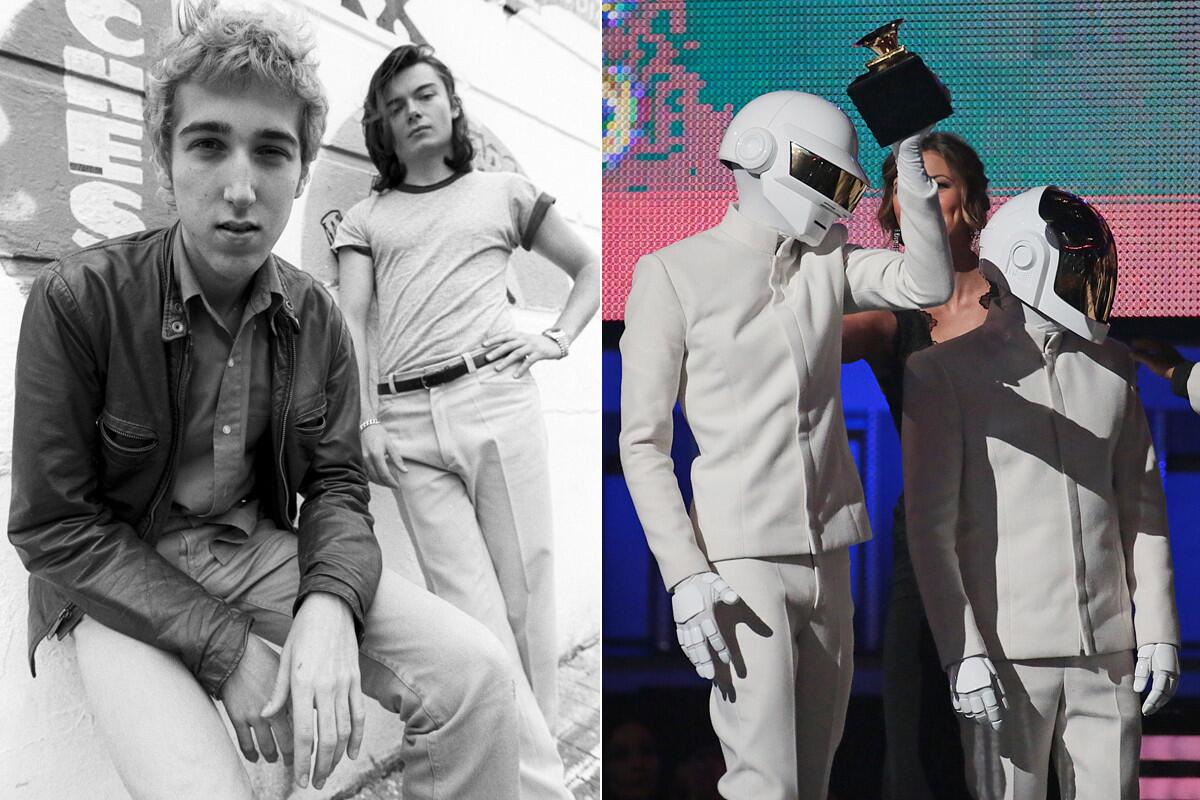
To the pop cognoscenti, the French dance-music duo Daft Punk exists as an ideal, modern musicdom’s most consistent, influential, enigmatic trailblazer, in addition to being crowned the major winner of the 2014 Grammy Awards by scoring record of the year and album of the year trophies.
But to another section of the population — those willfully ignorant of this year’s Coachella lineup, for instance — the question Sunday might have been: Who were those masked robots?
Thanks to Daft Punk’s abiding silence at the awards podium, its members’ identities obscured by futuristic helmets straight out of Isaac Asimov’s imagination — not to mention the mystique cultivated by remaining off camera for more than half of their performance of the ubiquitous “Get Lucky” with Nile Rodgers, Pharrell Williams and Stevie Wonder — the French duo spoke volumes about their selective embrace of the celebrity spotlight.
Contrary to misperceptions, Daft Punk’s Thomas Bangalter and Guy-Manuel de Homem-Christo speak fluent English. And despite rarely granting interviews, the two are hardly shy about expressing themselves. Splitting time between their native Paris and Los Angeles, they operate their production company Daft Arts out of Hollywood’s Jim Henson complex in the shadow of a giant Kermit the Frog sculpture.
Since 2001, however, they have refused to appear in public as Daft Punk without their robot disguises. Few outside of a core group of collaborators and friends could pick De Homem-Christo and Bangalter, both 39, out of a police lineup.
Grammys 2014: Full coverage | Top nominees and winners | Red carpet | Show highlights
This correspondent interviewed Daft Punk in 2010 — the year the duo abandoned funked-out Big Beat electronica to venture into symphonic music with the soundtrack for “Tron: Legacy” — and can report on what the men (who collaborator Pharrell simply refers to as “the robots”) look like beneath the helmets.
Bangalter is tall and slim with a head full of corkscrew brown curls and two-days’ growth of stubble. Imagine a hipster version of Michael Richards’ Kramer character from “Seinfeld” — albeit one who can speak impressionistically on the merits of Japanese animé, psych-rock and violin arpeggios — and you’re on the right track. Half a head shorter, matinee-idol handsome and exuding an air of Byronic melancholy, De Homem-Christo is the more intense of the two, all pensive silences and halting remarks.
Refusing to divulge their division of labor, the group members have remained in lock step regarding Daft Punk’s uncompromising artistry — its avoidance of market-driven trends (basically abandoning the EDM sound that spawned a thousand imitators) in favor of pursuing their own quirky agenda (i.e., the labor-intensive, handmade disco aesthetic of their album “Random Access Memories”), rewriting the rules of mainstream pop in the process.
“We’re interested in the line between fiction and reality, creating these fictional personas that exist in real life,” Bangalter said in a Rolling Stone interview last year, placing their disguises within a continuum of theatrical pop performers that includes Kraftwerk, David Bowie’s Ziggy Stardust incarnation and KISS. “People thought the helmets were marketing or something, but for us it was sci-fi glam.”
TIMELINE: Grammy Awards through the years | PHOTOS: Best & worst moments
A full generation older than their non-mask-wearing contemporaries in the electronic dance music field — including Skrillex, 26, and Avicii, 24 — Daft Punk’s relative anonymity remains intact in an era of rampant over-sharing and performers pursuing fame for fame’s sake.
“Daft Punk creates music and visuals in a very pure way,” the group’s manager, Paul Hahn, told The L.A. Times last October. “It starts with self-identity. The band doesn’t say to itself, ‘This is avant garde so it should be underground. More, they ask, ‘Why not? Why can’t our music be a big event?’”
On Sunday, after walking off with top Grammys honors, De Homem-Christo and Bangalter finally removed their helmets to host a lavish after-party, taking over two floors at Los Angeles’ venerable club venue the Park Plaza Hotel — Daft Punk’s first public celebration of “Random Access Memories” since its 2013 pre-release.
Before a celebrity-studded crowd that reportedly included Jay Z and wife Beyoncé; Madonna and her teenage daughter, Lourdes; Paul McCartney; Trent Reznor; actress Ellen Page and 30 Seconds to Mars frontman-turned-Oscar nominee Jared Leto, Bangalter — or at least someone several sources identified as “the tall one with gray hair” — ascended to the DJ booth to spin choice tunes including a remix of Daft Punk’s “Lose Yourself to Dance.”
Was it really a member of Daft Punk? Whoever the disc jockey was, he let the music do the talking.